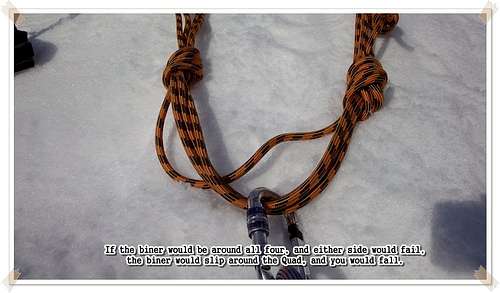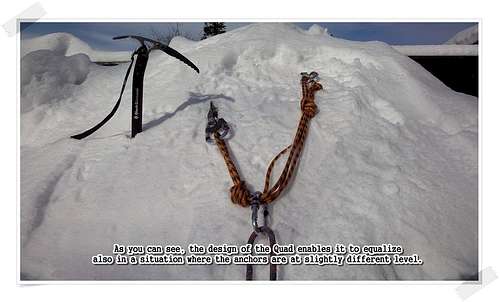Definition of a good Anchor
Let us start with the basic question: What is a good anchor?
A good anchor in any setting, be it snow, ice or rock, should have a set of properties to maximize the security of the anchor in question. To remember these, you can use the acronym EARNEST:
E - Equalized
A - Angle less then 60 degrees
R - Redundant
NE - No Extension
S - Solid
T - Timely
To make sure you understand these the same way I do, here are some brief notes on each.
Equalized - Your anchor should always have at least two points of contact to the ground (ice, or snow), and the load should be distributed as evenly as possible between these two points.
Angle - The angle between the contact points to the ground and the attachment point to the rope should be less than 60 degrees. For more information, please check this
article on Wikipedia. In simple terms: Try to make sure that the resulting V-formation of the anchor is as narrow as possible.
Redundant - The resulting anchor should be redundant for every part in it. In simple terms, pay attention to every piece of gear you have installed; if any one of them should break, you should always have secondary security built into the anchor. No single failure should lead to total failure of the anchor. (please note that in the images to the right, only one biner is used to clip the rope. For a fully redundant system you should have two, but the second is omitted from the images for sake of clarity)
No Extension - There should be no extension, or slack, in the system. The more extension there is, the more brutal the shock forces will be in a case of a fall. The length of the middle part of the Quad, between the overhand knots, affects the amount of potential slack in a partial failure situation. A wider middle means more potential slack.
Solid - The ground (snow, or ice) into which your anchor is attached should be as solid as possible. Also, all knots in the system should be properly dressed.
Timely - This is where it becomes sort of complicated: you need to address each point mentioned above, but still you should be able to deploy the anchor within reasonable time frame. Especially in Alpine conditions, the longer you expose yourself to the elements, the higher the objective hazards tend to grow.
What is a Quad, then?
A Quad, basically, is a pre-built system of some cord and a few biners that will help you address many of the points mentioned above in a timely manner.
It is essentially a double loop of cord, with two
overhand knots along the way and with a locking carabiner on each end.
The Quad fulfills these requirements of a good anchor:
1) It is automatically equalized (as long as the two anchor points are not too far away from each other)
2) It is redundant
3) When placed correctly, it has no slack or extension
4) It is very quick to place, thus it is timely
The only drawbacks I can think of are:
1) This should only be used by people who understand the mechanics, and could build an anchor without a Quad. You should not build one for your beginner friend, without him or her understanding why and how it works.
2) It can be a bit bulky (especially if you use 8mm cord like I do).
3) The stress tends to build into the same spots every time. You must keep an eye on your Quad, and watch out for wear and tear closely.
How to build a Quad?
What you need in order to build one are:
- 6 meters of cord, 6mm or more (I personally use 8mm)
- 2 locking biners
- knowledge of how to tie a
double fisherman's knot
- knowledge of how to tie a
overhand knot
1) Make a loop out of the cord. Use a double fisherman's to tie the ends together.
2) Twist the loop so that it is doubled.
3) At around quarter of the length from either end, tie an overhand knot. Make sure the double fisherman is at either end, and not in the middle section.
4) Clip a locking carabiner to each end of the Quad
The Quad is now ready to deploy!
How and When to use a Quad
You clip the Quad into bolts, ice screws or other choice of protection which is connected to the ground. You then clip yet another carabiner in the middle, between the overhand knots, and clip the rope into that biner.
The thing to keep in mind, is that you should
never clip around all four strands of cord in the middle. Always clip around 3, and leave 1 alone. This is very important: if either end of the Quad should fail, the Quad will remain secure only if you have not clipped around all 4 strands, thus enabling the carabiner between the Quad and your rope to slip off the Quad.
The Quad works best in top-roping, or pre-bolted multi-pitch routes, where you will save quite a bit of time over a long route.
On ice or snow, a third piece of protection is ideal, so Quad may not be your best choice, unless you have very solid ice.
External links
This website has a video demonstrating the process of making a Quad, as well as using it:
Obsessive Climbing.
There is also a
discussion on the SP forums about the use of Quads in climbing. Please see it for additional comments.












Comments
Post a Comment